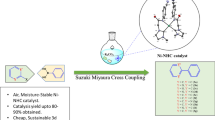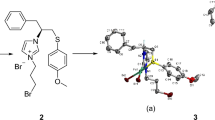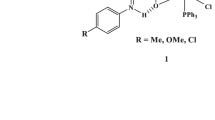Abstract
Three copper complexes {[Cu2(L1)2]·I3} n (1), [Cu(L2)2] (2), and [Cu2I2(L3)2(MBI)2] (3) (MBI = 2-mercaptobenzimidazole, L1 = N-(benzothiazol-2-yl)acetamidine anion, L2 = N-(thiazol-2-yl) acetamidine anion, L3 = 3-methyl-[1,2,4]thiadiazolo[4,5-a]benzimidazole) have been synthesized solvothermally by the reactions of CuI with 2-benzothiazolamine, 2-aminothiazole and 2-mercaptobenzimidazole (MBI), respectively, in acetonitrile. In situ C–N (or C–S) cross-coupling ligand reactions were observed in all three complexes, and hypothetical reaction mechanisms are proposed for the formation of the ligands and their complexes. The single-crystal X-ray structural analysis reveals that both the Cu(II) and Cu(I) atoms are located in pseudo-tetrahedral environments in complex 1, and L1 acts as a double bidentate ligand which coordinates with the Cu(I) and Cu(II) atoms to form a 1D coordination polymer. Unlike complex 1, the Cu(II) atom in complex 2 is in a square planar geometry, coordinated by two L2 ligands with relatively small steric hindrance. In complex 3, the Cu(I) atoms have a distorted tetrahedral geometry, being coordinated by one nitrogen atom from L3, two sulfur atoms of MBI ligands, and one iodide. The sulfur atoms from MBI ligands bridge two Cu(I) atoms to form a binuclear complex. All three complexes exhibit relatively high thermal stabilities. Complex 1 displays intense fluorescence emission at 382 nm and complex 3 displays two intense fluorescence emissions at 401 and 555 nm.







Similar content being viewed by others
References
Chen XM, Tong ML (2007) Acc Chem Res 40:162
Zhang XM (2005) Coord Chem Rev 249:1201
Han ZB, He YK, Ge CH, Ribas J, Xu L (2007) Dalton Trans 28:3020
Yang WB, Liu C, Qiu JS (2010) Chem Commun 46:2659
Qiu YC, Li YH, Peng G, Cai JB, Jin LM, Ma L, Peng H, Zeller M, Batten SR (2010) Cryst Growth Des 10:1332
Hu XX, Xu JQ, Cheng P, Chen XY, Cui XY, Song JF, Yang GD, Wang TG (2004) Inorg Chem 43:2261
Wang SH, Zheng FK, Wu MF, Liu ZF, Chen J, Guo GC, Huang JS (2012) Inorg Chem Commun 24:186
Sheldrick GM (1996) SADABS. Program for area detector adsorption correction. Institute for Inorganic Chemistry, University of Gottingen, Germany
Sheldrick GM (1997) SHELX-97. Program for the solution of crystal structures. University of Goettingen, Germany
Rousselet G, Capdevielle P, Maumy M (1993) Tetrahedron Lett 34:6395
Deng YH, Liu J, Zhang QJ, Li F, Yang YL, Li PZ, Ma J (2008) Inorg Chem Commun 11:433
Bishop MM, Lindoy LF, Miller DJ Turner P (2002) J Chem Soc Dalton Trans 4128. doi:10.1039/b207031f
Xu F, Sun JH, Shen Q (2002) Tetrahedron Lett 43:1867
Brown ID, Altermatt D (1985) Acta Crystallogr B41:244
Thorp HH (1992) Inorg Chem 31:1585
Peng R, Li M, Li D (2010) Coord Chem Rev 254:1
Fang SM, Zhang Q, Hu M, Xiao B, Zhou LM, Sun GH, Gao LJ, Du M, Liu CS (2010) CrystEngComm 12:2203
Perruchas S, Goff XFL, Maron S, Maurin I, Guillen F, Garcia A, Gacoin T, Boilot JP (2010) J Am Chem Soc 132:10967
Braga D, Maini L, Mazzeo PP, Ventura B (2010) Chem Eur J 16:1553
Zhang Y, Wu T, Liu R, Dou T, Bu XH, Feng PY (2010) Cryst Growth Des 10:2047
Zhou WX, Yin B, Li J, Sun WJ, Zhang FX (2013) Inorg Chim Acta 408:209
Armaroli N, Accorsi G, Cardinali F, Listorti A (2007) Top Curr Chem 280:69
Acknowledgments
This work was supported by the National Nature Science Foundation of China (Project Nos. 21271148, J1210057 and J1103311) that resulted in this article. CCDC 1004925–1004927 contains the supplementary crystallographic data for this paper. The data can be obtained free of charge from the Cambridge Crystallographic Data Center via http://www.ccdc.cam.ac.uk/data_request/cif.
Author information
Authors and Affiliations
Corresponding author
Additional information
Lin Yuan and Wang-yang Ma contributed equally to this work and should be considered co-first authors.
Rights and permissions
About this article
Cite this article
Yuan, L., Ma, Wy., Wang, C. et al. Synthesis, structures and properties of three copper complexes created via in situ ligand cross-coupling reactions. Transition Met Chem 39, 859–866 (2014). https://doi.org/10.1007/s11243-014-9869-y
Received:
Accepted:
Published:
Issue Date:
DOI: https://doi.org/10.1007/s11243-014-9869-y




